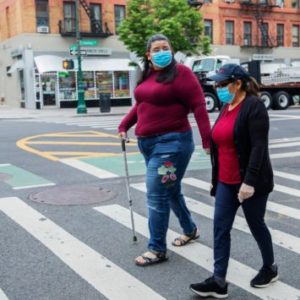
The COVID-19 pandemic has exposed one of our medical system’s greatest failures: giant bills. Janet Mendez, a COVID-19 survivor, is facing an enormous bill of more than $400,000. The first time she saw the bill, she assumed it was a mistake. “Maybe the hospital doesn’t have my insurance,” she thought. After almost three weeks in the hospital, she moved back in with her parents she was focused on “trying to get back to basics – walking, showering, et cetera.”
Then the second bill came, at a time when she was still relying on help from others to do basic tasks. Janet was terrified. She was planning on buying a house, but facing a medical bill just short of $402,000 uprooted her entire life. In the midst of her recovery, she was preoccupied with her enormous medical bill. “When am I gonna pay this? When will I afford a house?”
Janet worried about who she could turn to for help. She went to her sister, who works for New York Senator Gustavo Rivera (D, WF-33). After speaking with him, and after the New York Times ran her story, things were looking up.
What does she owe?
In the two months since her story became public, Janet has still struggled to find out what she truly owes. Mount Sinai froze her billing account for review, and she’s gotten no clarification on what her bill will be. If anything, Janet estimates that “because of my out-of-pocket net worth, I’ll probably pay about $10,000.” Even now, after all she’s been through, she’s still not sure what is owed.
The bills Janet has received have not helped her figure out what she owes either. “If you have so many personnel to bill from each department, why can’t it be consolidated? Why can’t I just get one bill?” She was overwhelmed by the amount of information coming her way, especially when she was struggling to overcome COVID: “each doctor, pharmacy, et cetera, was all over the map for in or out of network. I didn’t know what was in pocket, out of pocket… these health terms.”
What would she do differently?
Janet’s experience with billing has left her seeking change. “It’s too expensive to have insurance,” Janet said. “I pay $700 a month through Obamacare, but I still had to pay $200-300 for a doctor’s visit. I don’t get sick that often! Why do I have to pay so much for just basic health insurance?”
Janet has a vision for a better health system. She wants “a fair way to make insurance as equal as possible for everyone, not just based on how much you’re paying.” Her focus is on making sure care is accessible, “not just for single householders, [but] especially for the working class that doesn’t qualify for financial assistance, for undocumented workers – during a pandemic, they run things, but they’re working and being exposed because they have no alternatives.” She also wants more clarity on why she’s being charged: “make billing easier – simplify the codes and itemize the bills.”
Janet’s story is both unique and familiar; while few have seen bills as gargantuan as hers, thousands of New Yorkers just like Janet have struggled with convoluted medical bills. As New York progresses through the COVID-19 pandemic, these types of stories remind us of the dramatic change we need in our health system. Patients like Janet should come first – receiving clear bills for care and being told what care was provided and why – and not insurer profits.
Featured image: Calla Kessler/The New York Times


